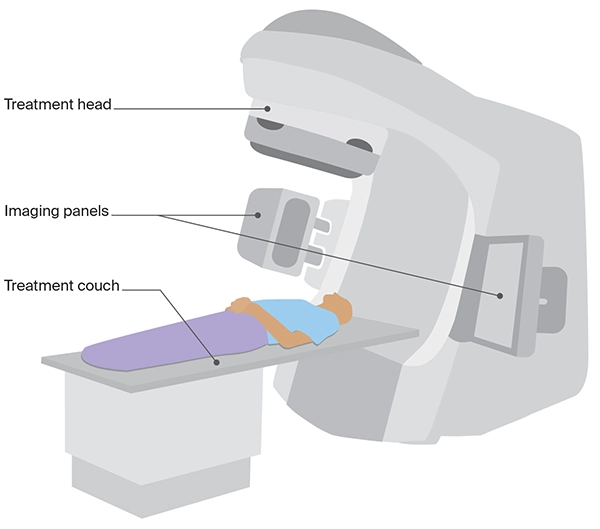- Home
- About Cancer
- Cancer treatment
- Radiation therapy
- External beam radiation therapy (EBRT)
External beam radiation therapy (EBRT)
External beam radiation therapy (EBRT) is the most common type of radiation therapy. It directs high-energy radiation beams at the cancer.
Learn more about:
- How EBRT works
- The linear accelerator
- Common types of EBRT
- Planning the EBRT treatment
- What to expect at treatment sessions
- Imaging scans you may have
- Specialised types of EBRT
How EBRT works
EBRT is delivered using a radiation machine. The most common type is a linear accelerator (LINAC, see below).
You will lie on a treatment table or “couch” under the machine. The machine does not touch you, but it will rotate around you to deliver radiation to the area with cancer from different directions. This allows the radiation beam to be more precisely targeted at the cancer and limits the radiation given to surrounding normal tissues. The radiation beam is on for only a few minutes and you won’t see or feel anything.
Linear accelerator (LINAC)

This is a general illustration of a LINAC, the most commonly used machine for delivering EBRT. The LINAC used for your treatment may look different.
A LINAC is large and often kept in a separate room. An imaging device, such as a CT imaging panel, is usually attached to the LINAC. This helps position you accurately on the couch so that the correct area of the body receives the radiation. The radiation beam comes out of the treatment head, which moves around you while you lie still on the couch.
Common types of EBRT
EBRT can be given using different techniques and types of radiation. The radiation oncologist will recommend the most suitable method for you. If you need a type of radiation therapy that is not available at your local hospital, they may arrange for you to have it at another centre.
Most machines use imaging scans before and during treatment to check you are in the correct position. This is known as image-guided radiation therapy (IGRT). It may use x-rays, a CT scan or an MRI scan.
| Three-dimensional conformal radiation therapy (3DCRT) | This is the basic form of modern EBRT using a LINAC. It shapes (conforms) the radiation beam to fit the treatment area. |
| Intensity-modulated radiation therapy (IMRT) | This is a highly accurate type of conformal radiation therapy. It shapes and divides multiple beams of radiation into tiny beams (beamlets) to closely fit the tumour while healthy tissue nearby receives lower doses of radiation. |
| Volumetric modulated arc therapy (VMAT) or rapid arc | This is a more advanced type of IMRT. As the machine moves around you, it reshapes and changes the intensity of the radiation beam. |
| Stereotactic radiosurgery (SRS) and stereotactic radiation therapy (SRT) | These are specialised types of radiation therapy used for brain tumours, not a type of surgery. Many small beams of radiation are aimed at the tumour from different directions to target the exact shape of the tumour. It may be delivered by a different type of machine, such as a Gamma Knife or CyberKnife. |
| Stereotactic body radiation therapy (SBRT) | Also known as stereotactic ablative body radiation therapy (SABR), this method combines many small beams of radiation from different angles to target the exact shape of the tumour. It may be delivered by a different type of machine, such as a Gamma Knife. |
→ READ MORE: Planning the EBRT treatment
Podcast: Making Treatment Decisions
Listen to more episodes from our podcast for people affected by cancer
More resources
A/Prof Susan Carroll, Senior Staff Specialist, Radiation Oncology, Royal North Shore Hospital, and The University of Sydney, NSW; Katie Benton, Advanced Dietitian Oncology, Sunshine Coast Hospital and Health Service, QLD; Adrian Gibbs, Director of Physics, Radiation Oncology, Princess Alexandra Hospital Raymond Terrace, QLD; Sinead Hanley, Consumer; Dr Annie Ho, Radiation Oncologist, GenesisCare, Macquarie University Hospital and St Vincent’s Hospital, NSW; Angelo Katsilis, Clinical Manager Radiation Therapist, Department of Radiation Oncology, Royal Adelaide Hospital, SA; Candice Kwet-On, 13 11 20 Consultant, Cancer Council Victoria; Jasmine Nguyen, Radiation Therapist, GenesisCare Hollywood, WA; Graham Rees, Consumer; Nicole Shackleton, Radiation Therapist, GenesisCare Murdoch, WA; Dr Tom Shakespeare, Director, Cancer Services, Mid North Coast Local Health District, NSW; Gabrielle Vigar, Nurse Lead, Cancer Program, Royal Adelaide Hospital and Queen Elizabeth Hospital, SA.
.
View the Cancer Council NSW editorial policy.
View all publications or call 13 11 20 for free printed copies.


